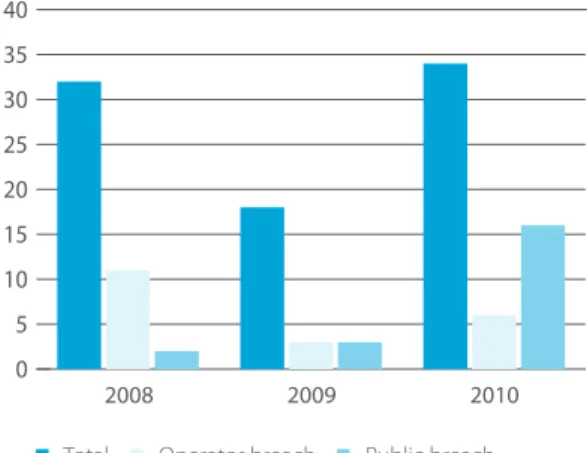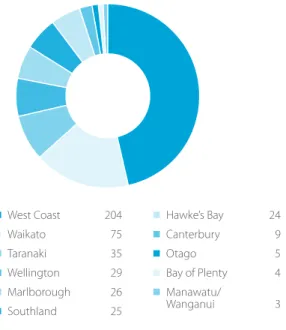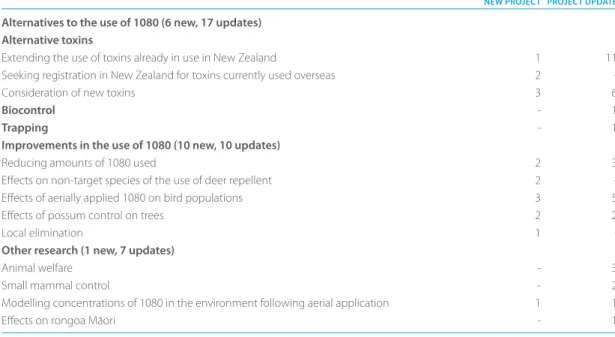The functions and powers of the Environmental Risk Management Authority (ERMA New Zealand), including responsibility for monitoring and reporting on air 1080 operations, were transferred to the Environment Protection Authority (EPA) on 1 July 2011. This data provides a snapshot of the sizes of the areas treated by aerial application in the current year and does not necessarily indicate a trend. This reflects the fact that a significant part of the Animal Health Board's treatment area includes agricultural land, with air 1080 used on the edge.
The number of 1080 aerial operations in each region, and the sectors using 1080, vary depending on the purpose of the operation, topography and land cover (see Table 3). The size of the operation may depend on the purpose and location of the operation. The purpose of notice is to inform affected parties of the timing and location of 1080 operations and other relevant details.
Reporting concerns were forwarded to the Environmental Protection Authority by operators, agencies or members of the public for six of the 45 1080 flights conducted in 2010.

Monitoring
Changes in business operations as a result of consultation Changes in business operations as a result of consultation are regarded as an indication of whether the consultation was effective. Before authorizing a 1080 operation from the air, the Public Health Units review the consultation against the Communications Directive for 1080 flights.20 The Ministry of Health reports the results of these assessments to the Environmental Protection Authority. The Department of Health reported that in 2010, 65 applications for 1080 airborne operations were reviewed for this directive.
No deficiencies were found in the pre-operative communication process as a result of subsequent investigations. Water monitoring may also be required in other water catchment areas as part of environmental monitoring for resource consents or carried out for research purposes. Post-operational water monitoring was carried out on 14 of the 1080 air operations undertaken in 2010, with 122 tests reported.
No 1080 was detected in any samples taken as part of environmental monitoring, or as part of post-operational water monitoring in drinking water catchments. The monitoring of plant and animal species is carried out to determine the need for pest control operations and their success. Pre-operational monitoring of pest species was carried out on 34 (75 per cent) of the air 1080 operations undertaken in 2010.
Post-operational pest species monitoring was carried out on 29 (64 per cent) of the 1080 aerial operations in 2010. For all monitored operations, operators reported achieving their stated target pest control results.21 Non-target species monitoring was carried out on 13 operations for to determine the effects of 1080 on them. This monitoring is often conducted as part of research into the use of 1080 and is further summarized in the research section of this report.
Incidents and public concerns
The allegations of non-compliance for each of the allegations (sign deficiencies) were investigated by an enforcement officer from the local Public Health Unit and found to be unsubstantiated. A member of the public claimed her cat was poisoned by eating birds affected by the 1080 operation. The member of the public also alleged breaches of consent conditions, which were investigated by the Public Health Unit and found to be unfounded.
The allegations were turned over to an enforcement officer from the local public health unit for investigation. The allegations were referred to a Department of Labor enforcement officer for investigation. The operator was alerted by an enforcement officer from the local public health unit.
A member of the public claimed the operator had baited the Ross water supply catchment. The allegations were investigated by an enforcement officer from the local public health unit, who found that the flight lines for the operation did not match the allegations. A member of the public notified the operator that bait had been incorrectly placed on a road in the operational area.
The person found the baits before the "first inspection" of the road (as required by a permit from the Institute of Public Health). The operator reported the misuse to the authorities when the helicopter flew 12 meters off the line at the border of the operation. Several members of the public broke through the security cordon to reach the operational area and delay the planned drop.

Alternatives to the use of 1080
We have added the words “new” or “update” before the title of each research project to indicate whether the project began during the period covered by this report or is an update of a previously reported project. A field trial to determine the effectiveness of the airborne KoLEE is scheduled for winter 2011, and this project is expected to be completed by November 2011, but a re-evaluation application has not been submitted. Residue analysis has been completed and the results will be published in the Proceedings of European Vertebrate Pest.
Field trials were completed, but although cyanide is more humane than other poisons, ferrets avoided the cyanide, so further development of cyanide-based products was not pursued. Field trials were completed, but although cyanide is more humane than other poisons, pigs avoided the cyanide, so further development of cyanide-based products ceased. This project has been completed and sodium nitrite is now being pursued as an alternative poison for pigs (and possums).
The publication will be published in the journal before the end of 2011, after additional baseline data on pigs has been collected. Initial cage trials have been completed and further cage and field trials are planned for 2011–12. Research is ongoing and documentation has been submitted for registration with the New Zealand Food Safety Authority and for approval with the Environmental Protection Authority.
This project has been completed and the files on these studies will be used to assist with registration. Trials of new humane wild boar toxins that do not cause secondary poisoning in dogs have been completed and efficacy data obtained. PAPP registration for feral cats has been achieved and registration for feral cats is ongoing.
Biocontrol
Research into new methods of trapping
Improvements in the use of 1080
The data will shape managers' expectations regarding windows of exemption from rat predation on endangered species when aerial 1080 is used. A contract report will be submitted to the Animal Health Board at the end of the project in June 2013. A contract report will be submitted to the Animal Health Board at the end of the project in 2012.
Nest survival was 41 percent in South Okarito Forest, which is to be treated with antenna 1080 early in the 2011 nesting season. In the final year of the study, additional nests will be monitored in both the treated and untreated areas to measure the effect of predator control as a result of the decline at 1080. In the Hawdon Valley, where aerial 1080 was used twice in the last five years and stoats were caught, preliminary results showed that the density of adult hunkea was about 10 times greater than Rotoiti.
Client: Department of Conservation Contractor: Department of Conservation Monitoring of bird population dynamics at three locations where predators are monitored using the 1080 aerial application. Ordered by: Department of Conservation Performed by: Department of Conservation Department of Conservation staff developed protocols and priorities for quantifying bird mortality during Operation 1080 from the air. To create kea-friendly aerial 1080 operational specifications and determine if aerial 1080 operations lead to improved kea nesting success.
Improved estimates of kea survival and recruitment will be used to predict the likely impact of long-term airborne 1080 programs on kea numbers. To determine the rate of tree death under a possum control regimen using antenna 1080 compared to no control, by re-measuring tagged trees in Haast, Coromandel and Northern Urewera and analyzing the survival rates of trees in blocks that do and do not possum control. Contracted by: Animal Health Board Operated by: Department of Conservation To accurately demonstrate the effect of repeated aerial use of 1080 on a wide range of native wildlife, enabling a comprehensive assessment of costs and benefits to the native biodiversity becomes possible.
Other research
Commission: Animal Health Board Contractor: Landcare Research NZ Ltd To determine whether the use of Epro deer repellent and aerial seeding of 1080 decoys per point at low rates significantly alters non-target risks by quantifying the impact on selected native bird species and deer. Research has progressed in converting fixed-wing aircraft to apply 1080 aerial bait to reduce flying costs by up to 60 percent. All field work will be completed by May 2013 and reported to the Animal Health Commission.
Modeling of potential concentrations of 1080 in the environment after airborne update 1080 points: oecd test 307: Aerobic transformation of 1080 in soil. The degradation rate of 1080 in the tested soils was mainly dependent on the incubation temperature and the effect of soil moisture content varied between different soils. This study showed that biological degradation was the dominant mechanism for the transformation of 1080 in New Zealand soils, and microorganisms in New Zealand soils readily transformed and degraded 1080 residues under suitable climatic conditions.
A final report has been submitted to the Animal Health Board and the Department of Conservation, and the results were presented at the National Pest Control Agencies technical conference in November 2010. Field trials will be conducted this year to evaluate the transport of 1080 in runoff and bottom water monitoring. under simulated and natural rain conditions. Contracted by: Animal Health Board Operated by: Eco Research Associates Ltd Following evidence of naturally occurring 1080 in puha in a previous Animal Health Board study, researchers examined other New Zealand plants to see if natural occurrences of 1080 are more widespread used to be.
None of the plants sampled contained 1080, indicating that the previously observed presence of 1080 in puha was an unusual phenomenon for New Zealand. The natural occurrence of 1080 in plants in New Zealand is likely to be rare. PCE's 1080 Use Assessment Report: Predators, Poisons and Silent Forests can be found on the PCE website at www.pce.



